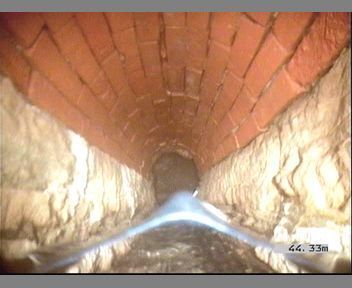Leamington culvert needed a new approach

Lanes’ reputation for tackling out of the ordinary relines was given another boost when the team faced an awkward manmade culvert in Leamington Spa.
As well as being an irregular shape and having a constantly varying diameter along its 47-metre length, the sewer involved eight lateral connections and defied the usual technology. But, thanks to a combination of methods and years of experience within the team, Lanes lined it in a weekend, earning the company a shortlisting for the UKSTT 2013 awards.
Right from the start, the Severn Trent Water (STW) sewer was a challenge. It was badly damaged but its location — running down the middle of a busy short-cut for commuters — meant that a fast repair was imperative. The area was also littered with other services, so traditional excavation would involve many more contractors, major disruption and additional costs. For these reasons, the site was earmarked for CIPP lining, but there were complications in the form of its shape and size — and its lateral connections.
Lying a metre beneath the road surface, the culvert had been hewn out of the ground so its sides were formed from rock. The bottom was not curved but flat, and the structure had been finished off with a brick roof. Thanks to this handcrafted build and erratic shape, the laser profiler designed to record changes to a given shape rather than actual measurements, was unable to gather meaningful data. Lanes had to carry out a man entry of the culvert to measure it and plot the laterals manually.
This exercise showed that the diameter ranged from 570mm up to 650mm, so a decision had to be made about what size of liner to use. A 600mm diameter was calculated as the best fit: an 18% give in the material would accommodate the 650mm maximum size, and both STW and the main contractor agreed to accept minor creasing in the liner where the diameter was smallest.
A 150mm diameter cast lateral pipe protruded into the culvert by 500mm at an angle at 12 o’clock. Lanes could not reline over it but when the team tried to cut it back using the KA-TE robotic cutter, there was a problem, as Gareth Parry-Jones, Project Manager, explained:
“The changing shape and width of the sewer meant we had to use the smallest KA-TE set up, but then the cutter couldn’t reach the pipe overhead; and even the Prokasro cutter, specifically designed for egg-shaped sewers, was unable to cope with this scenario.”
Instead, a mini excavation was planned to cut the pipe out just prior to the liner installation, so that the combined system pipe could be left open and once the liner was installed, the connection re-opened and the pipe cemented back in place.
With everything finally ready, enabling works complete; materials, plant and equipment in place, installation was scheduled for the weekend to minimise impact on commuting traffic.
On the day, the 12mm thick liner went in smoothly in the allotted timescale, but the culvert had one last conundrum for the team. After the liner had cured, the KA-TE robotic cutter was mobilised to open the laterals. Again though, thanks to the odd shape of the sewer, the advanced cutter was only able to access and re-open three of the connections.
After another urgent consultation with the contractor and STW, provisions were made for a further manual mission. The upstream manhole was capped off and though the weather was dry, overpumping set up, so that a confined spaces-trained operative could enter the culvert and cut the final four openings by hand, using air tools. (Ironically, the operative who completed this was six feet five inches tall!)
With all laterals finally opened, a survey showed that the relining had been a complete success to the delight of both STW and the main contractor. The irregularly shaped culvert with its varying diameter and protruding connection was once again structurally sound, thanks to Lanes’ no-dig knowhow.







